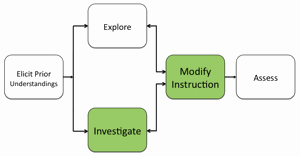Investigating Albedo
Students will be introduced to the effect of albedo on surface temperatures. Students will observe the change in surface temperature as dark and light surfaces are exposed to light energy. Students will understand how light reflection and absorption are related to albedo. Students will understand that lightly colored surfaces have higher albedo than darker colored surfaces.

1. Begin class by having students think about walking barefoot outside during the summer. Have students discuss which surface is more comfortable to walk on, a light colored sidewalk or a dark colored driveway or road.
2. Divide students into groups of four.
3. Distribute an Albedo Laboratory Guide and an Investigation Sheet to each student.
4. Instruct students to read the background information section in their Albedo Laboratory Guide.
5. Ask students to discuss and summarize what they read. Ask students how they think albedo is related to climate.
6. Inform students they will conduct an experiment to investigate the effect of albedo on surface temperatures during today’s class.
7. Instruct students to read through the laboratory procedures. Have students summarize the key points for their laboratory material use.
8. Instruct students to assemble paper envelopes and then place thermometers or temperature probes into the envelopes and position lamp above the envelopes as shown in the procedure.
Note: Ensure that heat from the lamps is reaching the thermometers or temperature probes.
9. Ask students to predict which color envelope will heat the fastest and which will reach the highest temperature. Instruct students to write their predictions on their Albedo Lab Investigation Sheet.
10. Instruct students to begin gathering data and to record their findings as instructed in the laboratory procedure.
IMPORTANT NOTES:
After students have collected data for 6 minutes, instruct them to discuss and note which color paper (white or black) has the lowest albedo (which envelope appears to have absorbed the most heat) and which color paper has the highest albedo (which envelope appears to have absorbed the least heat). Prompt students to record this information as “high” or “low” in the Albedo Ranking row on their data table.
11. Instruct students to turn off the light bulb immediately after the temperatures are recorded for the 8-minute interval. Remind students to not turn off their temperature data recorder if they are using a temperature probe.
12. Instruct students to complete the Albedo Lab Analysis section in their investigation sheet.
13. Ask student groups to share their results and evidence to support their conclusions with the class. Review analysis question responses.
14. Summarize the laboratory investigation with a brief discussion about climate feedback (see Albedo Lab Teacher Guide for more information).
15. Review the lesson concepts at the conclusion of the activity. Ensure that students understand that dark colored objects absorb more light energy that is then converted to heat energy. Dark colored objects reflect less light energy than lighter colored objects. Dark colored objects will heat up faster and reach a greater temperature than light colored objects. Darker colored objects have lower albedo than lighter colored objects.
Materials Needed:
Handouts
(1) Albedo Lab Teacher Guide (PDF / MS Word)
(2) Albedo Lab Student Handout (PDF / MS Word)
(3) Albedo Lab Investigation Sheet (PDF / MS Word)
Assessment Information
Teacher Resources/Content Support
Planetary Energy Balance - Print Version (PDF)
